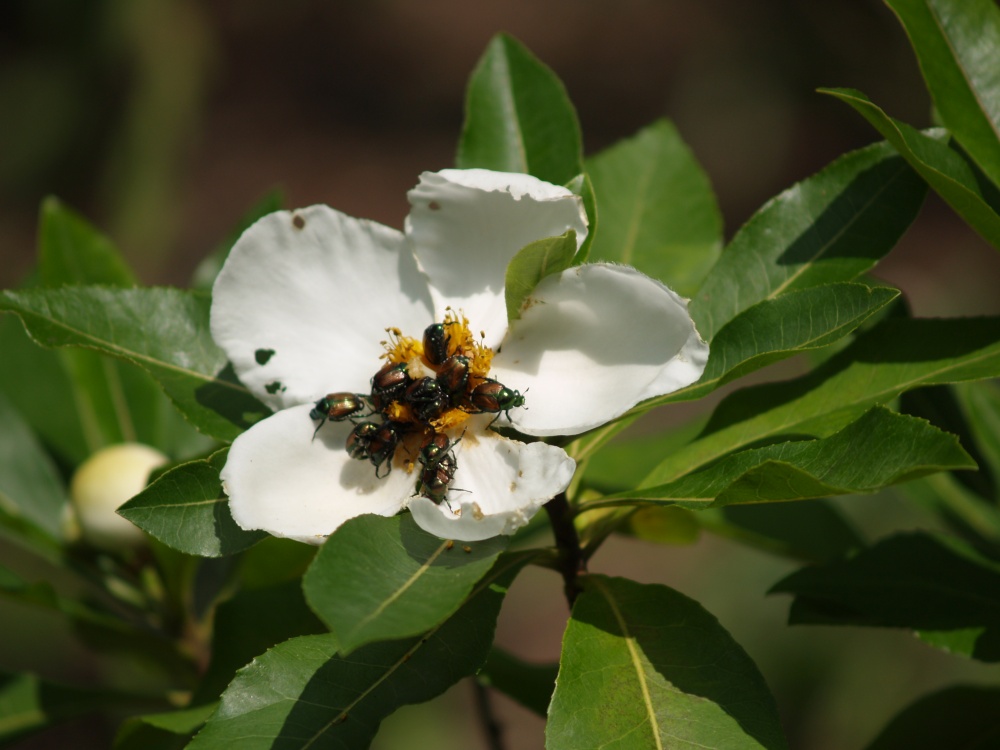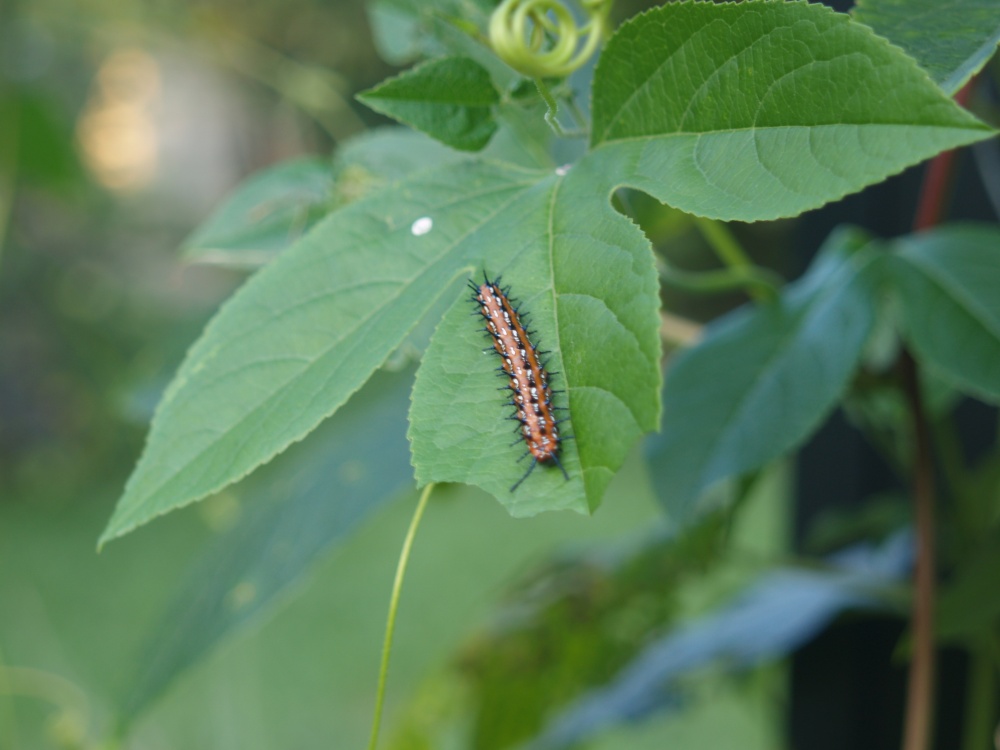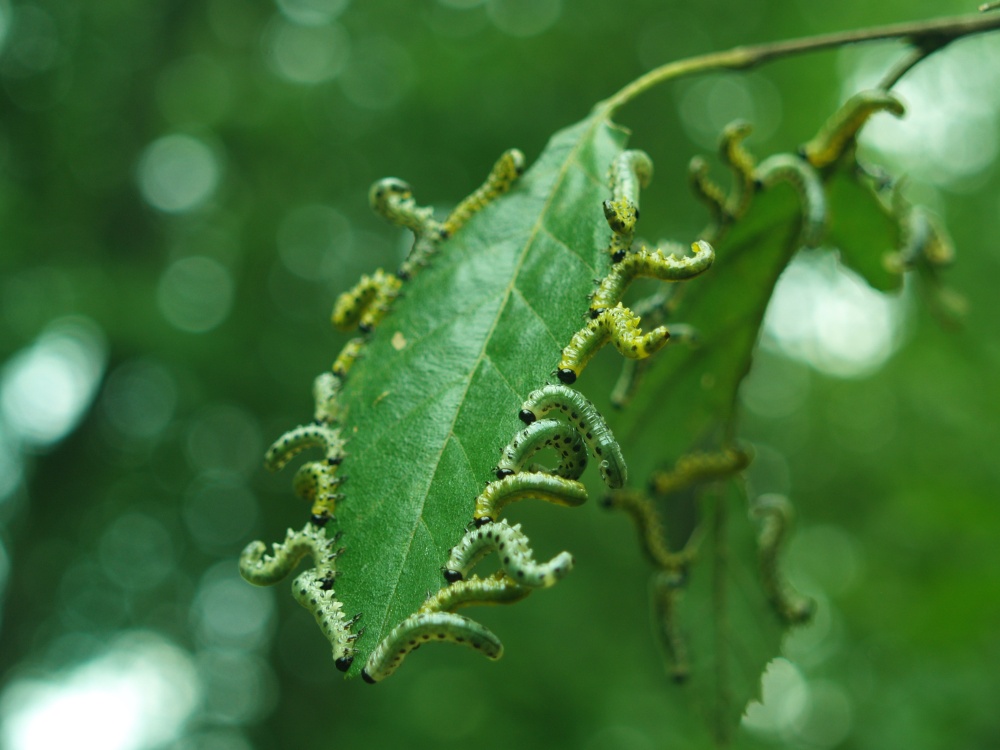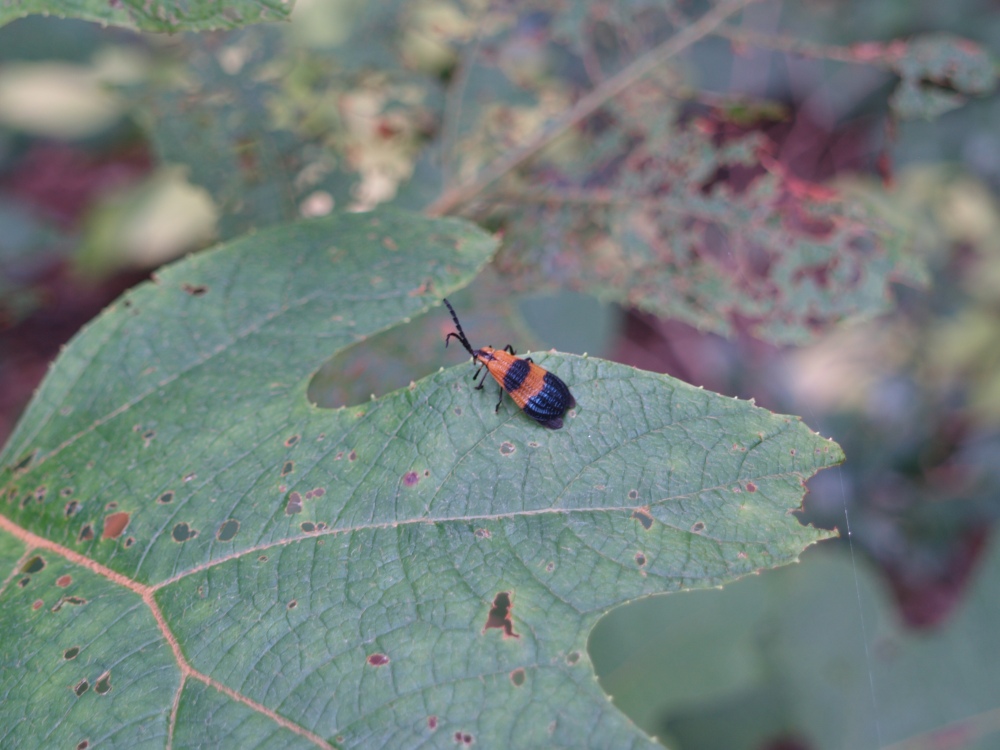I noticed recently that something was eating the redbuds (Cercis canadensis), both the red leafed ‘Forest Pansy’ and variegated ‘Silver Cloud’. First, I saw the webs, which I figured were the work of Fall webworms that are occasionally present in the garden, but rarely much of a problem. If I’m in the mood at the time, I might break open the web and displace the small caterpillars with a stream of water, but the redbuds are a bit too distant from the house without connecting multiple hoses, so I didn’t bother.
A few weeks later, I discovered that these were not webworms while mowing beneath the redbuds. As branches brushed my sleeveless shoulders I felt a sting, and when I reached to brush away what I supposed was a bee, I was stung again, and again. I’ve been stung before (and certainly will be again) by one beast or another, so I thought little of this until a few days later when I noticed bare spots and partially eaten leaves on the ‘Silver Cloud’ redbuds. As I leaned for a closer look I brushed another branch and was stung again. This time the culprit was identified.
The webs were now empty, with the caterpillars migrating throughout the sunny side of the trees (where nutrients levels are higher in foliage). Here, there were dozens, maybe hundreds of greenish-yellow caterpillars with a black stripe, and many fine hairs that deliver the sting. I’ve been stung by caterpillars before, so this was not shocking, but the stinging caterpillars I’d seen before were prominently marked and their stinging spines were more obvious. These were common looking caterpillars which were quickly identified after a short computer search as larvae of the White Flannel moth.
In fact, identification of caterpillars is simplified by researching the plant that they are chewing, rather than the caterpillars’ physical appearance. The White Flannel moth (above) feeds on only two trees, redbud and hackberry (Celtis occidentalis), but identification was important only as a matter of interest since I had and have no plans to spray a pesticide to be rid of them.
With any sign that a plant is being eaten or injured, the gardener must first identify the cause, then decide if the severity dictates that action be taken. Despite an annual infestation of Japanese beetles, I’ve decided that the damage done is more a nuisance than a problem, and that the controls necessary are too harsh, or laborious, to justify the treatment. Instead of pesticides, I’ve been advised that Japanese beetles can be picked and dropped into soapy water, but the minor injury caused by the small numbers of beetles does not justify this much work on my part, so I do nothing.
Several years ago, when the garden’s hostas began to disappear at an alarming rate, it was immediately clear that deer were the cause, and after delaying too long I decided to adopt a regular regimen of spraying a deer repellent. The repellent is harmless to deer, and to any other living creature, though after spraying one that stinks of rotten eggs my wife is hesitant to let me into the house for several hours. In this instance, I justify the solution as one that achieves its goal without harmful effect, and deer are readily able to find sustenance down the street instead of eating my garden’s treasures.

More or less, I’ve concluded the same with the White Flannel moth caterpillars, and with Gulf Fritillary caterpillars (above) that are chewing on the foliage of the Passion Flower vine (Passiflora incarnata). In past years the Golden Chain trees have been nearly defoliated by caterpillars, and earlier in the summer the Catalpa was stripped bare. All have recovered, and I expect the redbuds will manage as well.
There is less risk of damage late in the summer than with spring’s tent caterpillars that can quickly strip a tree’s new foliage. In a short period in late spring, the caterpillar of the Catalpa Sphinx moth did not leave a single whole leaf on the catalpa, which fortunately shows no signs of stress as it has grown nearly a full set of new leaves. Despite prodigious numbers of Sawfly larvae, little damage was done to a River birch (Betula nigra, below) a few years back.
Insects have damaged parts of Oakleaf hydrangeas (Hydrangea quercifolia, below), and other trees and shrubs to varying degrees. But, these are rarely more than cosmetic issues that gardener must decide to tolerate, or take actions that might effect other life in the garden. My decision not to spray pesticides is made in deference to the bees and birds that add immeasurably to my enjoyment of the garden, and if a few leaves are damaged, that is a small price to pay. But, I must be a bit more careful to avoid being stung.
I’m glad to hear someone else promoting the idea that a little leaf damage is not worth pulling out the poisons (pesticides). I love watching the insects in my garden and am wiling to loose leaves and the occasional plant rather than convert the garden to a perfect appearing wasteland.
Stepping off the soap box now…
Though I don’t spray for anything (and suffer very little downside for this) I understand that more pristine landscapes than mine might demand an occasional spot treatment. I am horrified that a few companies promote whole property spraying to eliminate mosquitoes or ticks (and also bees and earthworms).
Dave, you mentioned a “passion flower vine” in this older post. You are in eastern VA in zone 7 correct? Having lived in Florida and seen huge passion flower vines there, I was not aware that this exotic vine would grow in a cold climate. I am in Central VA, probably zone 6 or 7. Thank you.
Passiflora incarnata is rated as cold hardy to zone 5. There are many species of passion flower vine, and several are quite cold hardy. I also grow Passiflora lutea, which has much smaller, but more abundant yellow flowers. All have survived five and six degrees below zero in this garden. With a late spring, as we’ve experienced the past two years, the vines do not begin to grow until late May, but once started they grow and flower quickly.
Thank you so much for your response. I shall be scouting out the smaller nurseries and Meadows Farms to see if I can find some of the Passiflora vines come Spring.